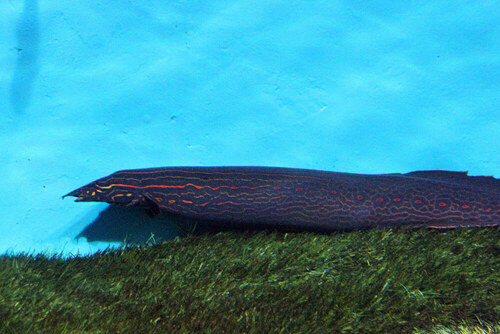
Fire Eel
The Atlantic Bluefin Tuna (Thunnus thynnus) is a highly migratory, large pelagic fish renowned for its size, speed, and commercial value. As one of the ocean's top predators, it plays a crucial role in the marine ecosystem. This species is remarkable for its physiological adaptations, including the ability to maintain a warm body temperature, which allows it to thrive in a wide range of oceanic environments.
8 18 years
Lifespan
100 cm
Length
Least Concern
Conservation Status
N/A km/h
Swimming speed
Carnivorous, Insectivorous
Diet
Local Migration
Migration
Appearance Overview
The Atlantic Bluefin Tuna showcases a metallic dark blue upper body with a silvery-white underside, designed for camouflage from above and below.
Color
Dark metallic blue above, silvery-white below
Body Shape
Torpedo-shaped, built for speed and endurance
Fins
Two dorsal fins, the first depressible; small finlets running from dorsal and anal fins to the tail
Length
Up to 13 feet (4 meters)
Weight
Up to 2,000 lbs (907 kg)
Diet
Carnivorous, feeding on a variety of fish, squid, crustaceans, and occasionally, zooplankton and eels.
Feeding Behavior
Highly active predators, Bluefin Tuna use their speed and agility to hunt. They often feed in groups, coordinating to herd and capture prey.
Social Behavior
Known to form schools, sometimes segregated by size. They are highly migratory, capable of crossing entire oceans.
Commercial Relevance
Extremely high value, especially in sushi and sashimi markets, where its meat, particularly the fatty belly (toro), is considered a delicacy.
Conservation measures
Subject to international fishing quotas, marine protected areas, and fishing gear restrictions to reduce bycatch. Efforts also include tagging programs to monitor populations and migration patterns.
Status
Endangered
Threats
Overfishing remains the primary threat. Other concerns include habitat degradation, climate change affecting prey distribution, and bycatch in fishing gear.
Habitat Distribution
Depth Range
0-3,300 feet (0-1,000 meters), most commonly found in the epipelagic zone.
Geographic Range
Primarily found in the North Atlantic Ocean, including the Mediterranean Sea.
Preferred Environment
Prefers temperate and subtropical waters; undertakes long migrations across the ocean, adapting to various water temperatures.
Reproduction and Life Cycle
Breeding Habits
Spawns in two main areas: the Mediterranean Sea and the Gulf of Mexico. Spawning typically occurs in warm waters during spring and summer.
Development Stages
Eggs hatch into larvae, which are planktonic and develop rapidly. Juveniles grow quickly, reaching significant size within their first year. The transition to adulthood involves extensive migrations.
Fecundity
Highly fecund; females can release up to 30 million eggs per spawning season, depending on their size and condition.
Maturity Age
Reaches sexual maturity relatively late, at around 4-8 years of age, depending on the population and environmental conditions.
Faqs about Fire Eel
How fast can Atlantic Bluefin Tuna swim?
Atlantic Bluefin Tuna are among the fastest fish in the ocean, capable of short bursts of speed up to 43 mph (70 km/h).
Do Bluefin Tuna migrate?
Yes, they are highly migratory and can travel thousands of miles across oceans for feeding and spawning.
What is the lifespan of an Atlantic Bluefin Tuna?
They can live up to 40 years, although the average lifespan is often shorter due to fishing pressure.
Are Bluefin Tuna warm-blooded?
Yes, bluefin tuna possess a unique ability to maintain a body temperature higher than the surrounding water, which helps them survive in colder waters and enhances their muscle efficiency for swimming.
Why are Atlantic Bluefin Tuna endangered?
Overfishing has drastically reduced their numbers, and they are highly sought after for sushi and sashimi, making sustainable fishing practices crucial for their survival.
Copyright @ Nature Style Limited. All Rights Reserved.
 English
English